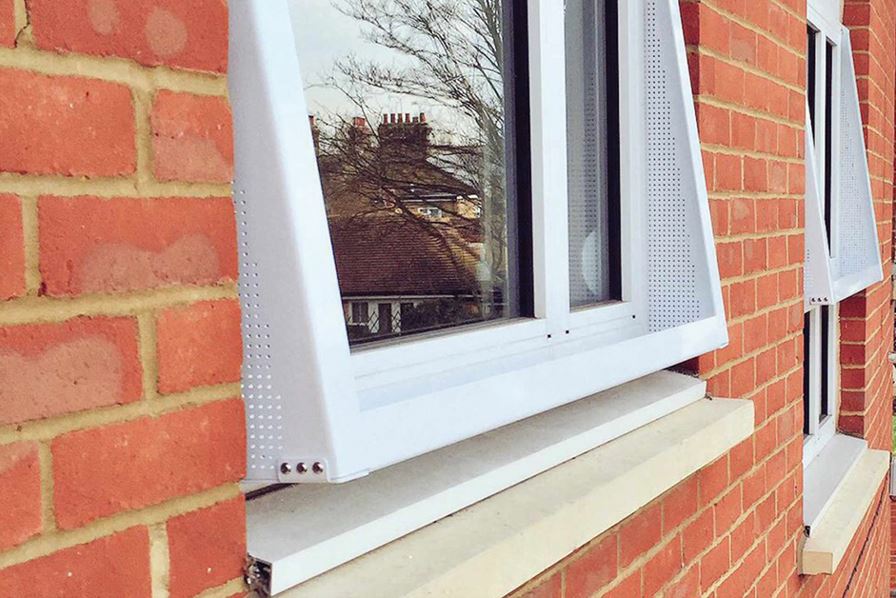There is growing acceptance that building design plays a central role in the wellbeing and recovery of hospital patients, not least those suffering from mental health conditions.
In particular, access to, or views out onto, gardens and landscaping have been found to have a direct impact on stress levels and can even lead to reduced reliance on painkillers and other medication. And one key part of the design process is the choice of windows – which enable patients and service users, even those confined to their bedrooms, to experience the natural world around them. Fourteen years ago, Kevin Gorman, chairman of UK-based commercial glazing specialist, Britplas, invented the Safevent window, which can now be found in psychiatric units across the UK and further afield.
A GAME CHANGER
Initially developed for Mersey Care NHS Foundation Trust, the product was a game changer as it was the first window which could be installed in secure mental health units, but could be opened to allow a flow of fresh air into patient areas. The double sliding window has one glazed area and the other is fitted with a stainless-steel mesh. The sliding sash is glazed, sealing the mesh side when closed and is weather tight and draughtproof. In this way, the window provides natural light and ventilation, which can be controlled by service users, yet also helps to maintain a safe, secure, and anti-ligature environment to meet the requirements of mental health facilities. Since it was first launched, the product has been developed and improved through multiple iterations, all driven by feedback and requests from mental health trusts. Gorman said: “While safety and security have always been primary drivers when it comes to the design of windows for mental health facilities, recent years have seen a much-greater emphasis placed on the therapeutic aspects of product design.
THE RIGHT SOLUTION
“And this has meant a move towards larger windows to enhance light transmission and improved sightlines via the use of slimmer frames. “There is also greater awareness of the importance of tailoring product design to specific user groups. So, for instance when it comes to older adult care, anti-ligature characteristics may not be such a major risk factor, but there can be a number of additional factors which must be taken into account, such as ease of use, familiarity with operation, visual cues, and so on.” Privacy and dignity are also driving R&D efforts in the industry. Gorman said: “Things like mirror film and integrated blinds are being used to great effect where privacy might otherwise be an issue, for instance in built-up areas or for the refurbishment of older buildings.” So, too, is carbon reduction impacting on manufacturing processes. Gorman explains: “Sustainability considerations are moving up the list of priorities with the Government’s drive towards net zero and thermal efficiency., and window performance is being constantly improved.”
EARLY ENGAGEMENT
When choosing windows for mental health new-build or refurbishment projects, Gorman advises specifiers to engage early with suppliers to make sure the windows are suitable for the user group. He adds: “Specifiers may wish to carry out their own testing, and your supplier should be happy to help facilitate this and to show you the results of prior relevant tests. “Also, look carefully at a supplier’s track record in the industry – What projects have they completed? How long have they been around? Are they financially secure? “As well as the product itself, consider the service element – does the supplier provide an end-to-end service, what sort of warranty is offered, and what are the lifecycle costs and considerations?” In the future, Gorman predicts that aesthetics and the patient experience will continue to underpin window design, together with the carbon net zero drive.

PUSHING BOUNDARIES
He said: “We have an R&D department that works full time on finding and making improvements to our existing products, and inventing new ones. “While our products will always focus on safety and patient usability, improving energy efficiency is key at the moment and we are currently looking at the full product lifecycle with a view to how we can do our bit to beat the Government’s emissions targets. “The adaptability of our products is also key, and we will continue to push boundaries with greater options for size, product combinations, and aesthetic impact. “For us, the best designs are usually the simplest ones and we have worked hard to pare back and simplify things like control mechanisms with the introduction of our Multask handle, which replaced three separate pieces of hardware.” Safehinge Primera has also spent the past few years developing its range of window restrictors and anti-ligature window handles to reflect the changing needs of mental health providers. In particular, it is taking a more-adaptive approach, enabling products to be procured which meet the particular needs of each mental health service. A spokesman said: “Ensuring window safety in mental health facilities and challenging environments is of paramount importance to create a secure and therapeutic environment for both patients and staff.
ASSESSING THE RISKS
“In high-risk areas, the implementation of fitted sliding windows critically enhances safety measures. “However, these high-risk solutions procure a higher cost and do not necessarily make economic sense for lower-risk areas or retrofit projects. “Instead of uniformly applying the same risk measures throughout a mental health facility, Safehinge Primera takes a risk-assessed approach to adapt to evolving risk and budget needs, conducted collaboratively with clinical experts. “This nuanced understanding empowers facilities to implement varying degrees of window restrictions based on the identified risks, thereby optimising the allocation of budget. “Such an approach ensures that the most-vulnerable areas receive heightened security measures, while less-critical areas can be managed with less-costly solutions, effectively striking a balance between safety and fiscal responsibility.” Patient wellbeing is, again, also a key driver in the development of window hardware.
THE OUTSIDE WORLD
The spokesman said: “Many window restrictors limit the view with integrated mesh placed within, or over, the glass, giving a more-institutional look and feel. “To Safehinge Primera, it is important that we focus on the patient’s recovery, allowing fresh air into a room, and an unrestrictive view of the outside world without grates or bars to spoil them. “Our restrictors do not limit the view, and the window pane itself is not covered or overlapped. “The restrictors and handles can also easily be retrofitted to existing windows, eliminating the need for very-expensive and disruptive window upgrade works and providing a cost-effective solution that strikes the perfect balance between accessibility and security, yet always prioritising patient wellbeing.”

